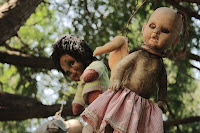This island today is known as
“La Isla de la Munecas”—The Island of the Dolls. This ghost story has one of
the strangest reactions to a haunting I have ever heard.
In the 1950s a man by the name of Don Julian Santana Barrera came to live on a small island on Teshuilo Lake just 18 miles west of Mexico City.
This island is located in Mexico’s ancient Xochimilco district. Santana a hermit at, a hermit at heart,e and family and choose this area for its isolation.
In the 1950s a man by the name of Don Julian Santana Barrera came to live on a small island on Teshuilo Lake just 18 miles west of Mexico City.
This island is located in Mexico’s ancient Xochimilco district. Santana a hermit at, a hermit at heart,e and family and choose this area for its isolation.
Santana was unaware of the
island's dark history when he moved to these wetlands accessed via a network of intricate canals.
Local legend states that in the 1920s, three young girls were playing on the island when one of them tragically fell into the murky waters of the canal and drowned.
After this, the local residents came to believe this young girl’s spirit was trapped on the island. The area soon gained a reputation for being haunted. People refused to go near it at night.
Local legend states that in the 1920s, three young girls were playing on the island when one of them tragically fell into the murky waters of the canal and drowned.
After this, the local residents came to believe this young girl’s spirit was trapped on the island. The area soon gained a reputation for being haunted. People refused to go near it at night.
Julian Santana claimed that
soon after he came to the island, the spirit of this little girl began to talk
to him.
She told him how she had died and requested he get some dolls for her to play with. She said these dolls would also ward off evil spirits that wandered the wetlands.
To please her, Santana started to acquire these dolls. He fished old dolls out of the dirty canal that ran past the island, he traveled back to more populated areas to raid garbage dumpsters for dolls and he even traded some of the fruits and vegetables he grew on the island for old dolls.
She told him how she had died and requested he get some dolls for her to play with. She said these dolls would also ward off evil spirits that wandered the wetlands.
To please her, Santana started to acquire these dolls. He fished old dolls out of the dirty canal that ran past the island, he traveled back to more populated areas to raid garbage dumpsters for dolls and he even traded some of the fruits and vegetables he grew on the island for old dolls.
For many years Sanatana was
left to his hermit existence. But then in the 1990s, Mexico invested over a
million dollars to be used to clean up the Xochimilco canals. This brought more water
traffic past Santana’s island.
Seeing over a thousand mutilated dolls hanging from every other tree on the island caused most of these outsiders to feel Santana was nutty.
But as time passed most people realized that he was just a harmless “odd” old man. It was at this point the island was dubbed “The Island of the Dolls.”
Seeing over a thousand mutilated dolls hanging from every other tree on the island caused most of these outsiders to feel Santana was nutty.
But as time passed most people realized that he was just a harmless “odd” old man. It was at this point the island was dubbed “The Island of the Dolls.”
As for the multitude of
dolls, Santana explained that no amount of these toys seemed to satisfy this young
spirit’s thirst.
In April of 2001, Santana expressed to his nephew; it was becoming more difficult for him to resist the strange voices that beckoned to him. He felt these voices wanted him to join them in their watery grave.
This same day when his nephew returned from some errands, he found his uncle floating face down in the canal. His body was in the same spot near the small pier where the girl had drowned seventy years before.
In April of 2001, Santana expressed to his nephew; it was becoming more difficult for him to resist the strange voices that beckoned to him. He felt these voices wanted him to join them in their watery grave.
This same day when his nephew returned from some errands, he found his uncle floating face down in the canal. His body was in the same spot near the small pier where the girl had drowned seventy years before.
Today “The Island of the
Dolls” is an eerie tourist destination. Visitors often state that these doll’s
soulless eyes glare at them. Others say they hear these dolls whisper to them
especially after sundown.


.jpg)
















.png)









